1.2: Temas e conceitos de biologia
- Page ID
- 181934
Habilidades para desenvolver
- Identifique e descreva as propriedades da vida
- Descreva os níveis de organização entre os seres vivos
- Reconhecer e interpretar uma árvore filogenética
- Listar exemplos de diferentes subdisciplinas em biologia
A biologia é a ciência que estuda a vida, mas o que exatamente é a vida? Isso pode parecer uma pergunta boba com uma resposta óbvia, mas nem sempre é fácil definir a vida. Por exemplo, um ramo da biologia chamado virologia estuda vírus, que exibem algumas das características de entidades vivas, mas carecem de outras. Acontece que, embora os vírus possam atacar organismos vivos, causar doenças e até se reproduzir, eles não atendem aos critérios que os biólogos usam para definir a vida. Consequentemente, os virologistas não são biólogos, estritamente falando. Da mesma forma, alguns biólogos estudam a evolução molecular inicial que deu origem à vida; como os eventos que precederam a vida não são eventos biológicos, esses cientistas também são excluídos da biologia no sentido estrito do termo.
Desde seus primórdios, a biologia se deparou com três questões: Quais são as propriedades compartilhadas que tornam algo “vivo”? E quando sabemos que algo está vivo, como podemos encontrar níveis significativos de organização em sua estrutura? E, finalmente, quando nos deparamos com a notável diversidade da vida, como organizamos os diferentes tipos de organismos para que possamos entendê-los melhor? À medida que novos organismos são descobertos todos os dias, os biólogos continuam buscando respostas para essas e outras questões.
Propriedades da vida
Todos os organismos vivos compartilham várias características ou funções principais: ordem, sensibilidade ou resposta ao meio ambiente, reprodução, adaptação, crescimento e desenvolvimento, regulação, homeostase, processamento de energia e evolução. Quando vistas em conjunto, essas nove características servem para definir a vida.
Pedido
Organismos são estruturas coordenadas e altamente organizadas que consistem em uma ou mais células. Mesmo organismos unicelulares muito simples são notavelmente complexos: dentro de cada célula, os átomos formam moléculas; estes, por sua vez, formam organelas celulares e outras inclusões celulares. Em organismos multicelulares (Figura\(\PageIndex{1}\)), células similares formam tecidos. Os tecidos, por sua vez, colaboram para criar órgãos (estruturas corporais com uma função distinta). Os órgãos trabalham juntos para formar sistemas orgânicos.
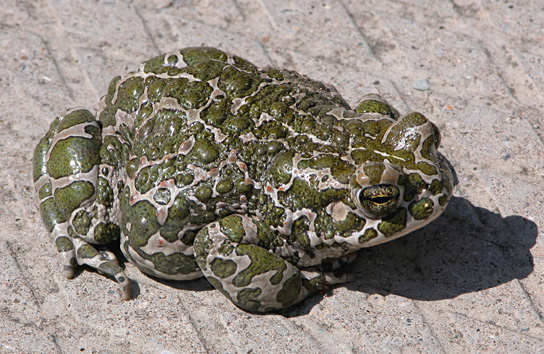
Sensibilidade ou resposta a estímulos
Os organismos respondem a diversos estímulos. Por exemplo, as plantas podem se curvar em direção a uma fonte de luz, subir em cercas e paredes ou responder ao toque (Figura\(\PageIndex{2}\)). Mesmo pequenas bactérias podem se aproximar ou se afastar de substâncias químicas (um processo chamado quimiotaxia) ou da luz (fototaxia). O movimento em direção a um estímulo é considerado uma resposta positiva, enquanto o afastamento de um estímulo é considerado uma resposta negativa.
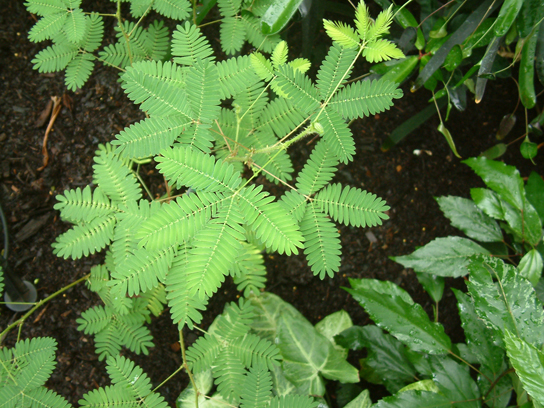
Link para o aprendizado
Vídeo: Assista a este vídeo para ver como as plantas respondem a um estímulo: da abertura à luz, ao enrolamento de uma gavinha ao redor de um galho e à captura de presas.
Reprodução
Organismos unicelulares se reproduzem primeiro duplicando seu DNA e depois dividindo-o igualmente enquanto a célula se prepara para se dividir para formar duas novas células. Organismos multicelulares geralmente produzem células germinativas reprodutivas especializadas que formarão novos indivíduos. Quando a reprodução ocorre, genes contendo DNA são transmitidos para a prole de um organismo. Esses genes garantem que a prole pertença à mesma espécie e tenha características semelhantes, como tamanho e forma.
Crescimento e desenvolvimento
Os organismos crescem e se desenvolvem seguindo instruções específicas codificadas por seus genes. Esses genes fornecem instruções que direcionarão o crescimento e o desenvolvimento celular, garantindo que os filhotes de uma espécie (Figura\(\PageIndex{3}\)) cresçam e exibam muitas das mesmas características de seus pais.

Regulamentação
Mesmo os organismos menores são complexos e requerem vários mecanismos regulatórios para coordenar as funções internas, responder aos estímulos e lidar com os estresses ambientais. Dois exemplos de funções internas reguladas em um organismo são o transporte de nutrientes e o fluxo sanguíneo. Órgãos (grupos de tecidos trabalhando juntos) desempenham funções específicas, como transportar oxigênio por todo o corpo, remover resíduos, fornecer nutrientes para cada célula e resfriar o corpo.
Homeostase
Para funcionar adequadamente, as células precisam ter condições adequadas, como temperatura, pH e concentração adequada de diversos produtos químicos. Essas condições podem, no entanto, mudar de um momento para o outro. Os organismos são capazes de manter as condições internas dentro de uma faixa estreita quase constantemente, apesar das mudanças ambientais, por meio da homeostase (literalmente, “estado estacionário”) - a capacidade de um organismo de manter condições internas constantes. Por exemplo, um organismo precisa regular a temperatura corporal por meio de um processo conhecido como termorregulação. Organismos que vivem em climas frios, como o urso polar (Figura\(\PageIndex{4}\)), têm estruturas corporais que os ajudam a suportar baixas temperaturas e conservar o calor corporal. As estruturas que auxiliam nesse tipo de isolamento incluem pele, penas, gordura e gordura. Em climas quentes, os organismos têm métodos (como transpiração em humanos ou ofegante em cães) que os ajudam a eliminar o excesso de calor corporal.
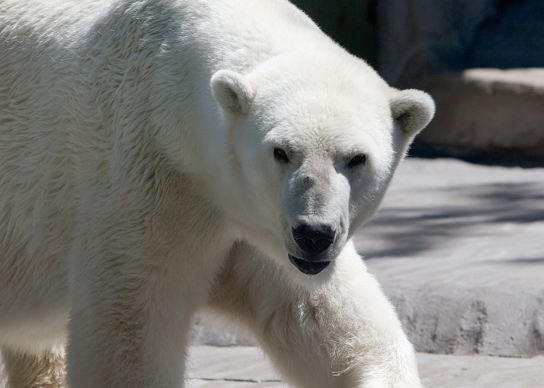
Processamento de energia
Todos os organismos usam uma fonte de energia para suas atividades metabólicas. Alguns organismos capturam energia do sol e a convertem em energia química nos alimentos; outros usam energia química nas moléculas que absorvem como alimento (Figura\(\PageIndex{5}\)).
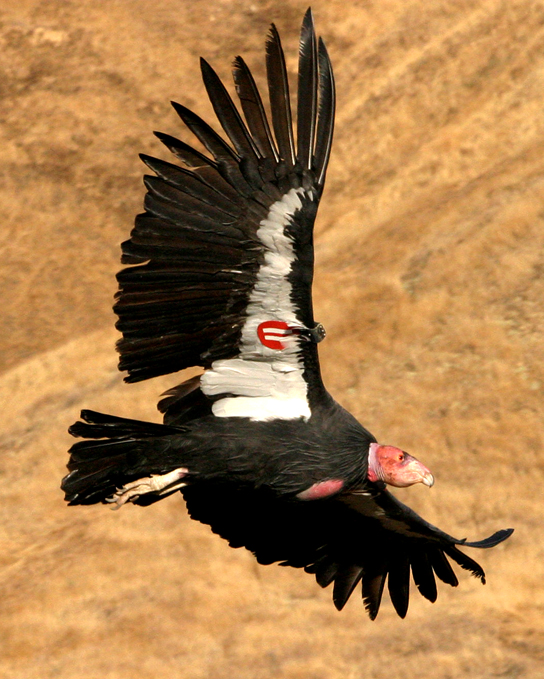
Níveis de organização dos seres vivos
Os seres vivos são altamente organizados e estruturados, seguindo uma hierarquia que pode ser examinada em uma escala de pequeno a grande. O átomo é a menor e mais fundamental unidade da matéria. Consiste em um núcleo cercado por elétrons. Os átomos formam moléculas. Uma molécula é uma estrutura química que consiste em pelo menos dois átomos mantidos juntos por uma ou mais ligações químicas. Muitas moléculas biologicamente importantes são macromoléculas, moléculas grandes que normalmente são formadas por polimerização (um polímero é uma molécula grande que é feita pela combinação de unidades menores chamadas monômeros, que são mais simples do que macromoléculas). Um exemplo de macromolécula é o ácido desoxirribonucléico (DNA) (Figura\(\PageIndex{6}\)), que contém as instruções para a estrutura e o funcionamento de todos os organismos vivos.
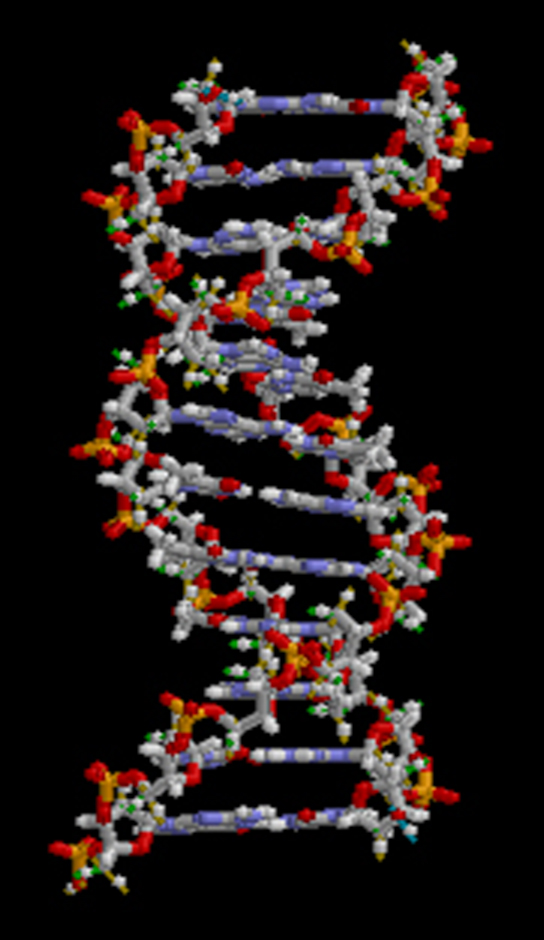
Link para o aprendizado

Vídeo: Assista a este vídeo que anima a estrutura tridimensional da molécula de DNA mostrada na Figura\(\PageIndex{6}\).
Some cells contain aggregates of macromolecules surrounded by membranes; these are called organelles. Organelles are small structures that exist within cells. Examples of organelles include mitochondria and chloroplasts, which carry out indispensable functions: mitochondria produce energy to power the cell, while chloroplasts enable green plants to utilize the energy in sunlight to make sugars. All living things are made of cells; the cell itself is the smallest fundamental unit of structure and function in living organisms. (This requirement is why viruses are not considered living: they are not made of cells. To make new viruses, they have to invade and hijack the reproductive mechanism of a living cell; only then can they obtain the materials they need to reproduce.) Some organisms consist of a single cell and others are multicellular. Cells are classified as prokaryotic or eukaryotic. Prokaryotes are single-celled or colonial organisms that do not have membrane-bound nuclei; in contrast, the cells of eukaryotes do have membrane-bound organelles and a membrane-bound nucleus.
In larger organisms, cells combine to make tissues, which are groups of similar cells carrying out similar or related functions. Organs are collections of tissues grouped together performing a common function. Organs are present not only in animals but also in plants. An organ system is a higher level of organization that consists of functionally related organs. Mammals have many organ systems. For instance, the circulatory system transports blood through the body and to and from the lungs; it includes organs such as the heart and blood vessels. Organisms are individual living entities. For example, each tree in a forest is an organism. Single-celled prokaryotes and single-celled eukaryotes are also considered organisms and are typically referred to as microorganisms.
All the individuals of a species living within a specific area are collectively called a population. For example, a forest may include many pine trees. All of these pine trees represent the population of pine trees in this forest. Different populations may live in the same specific area. For example, the forest with the pine trees includes populations of flowering plants and also insects and microbial populations. A community is the sum of populations inhabiting a particular area. For instance, all of the trees, flowers, insects, and other populations in a forest form the forest’s community. The forest itself is an ecosystem. An ecosystem consists of all the living things in a particular area together with the abiotic, non-living parts of that environment such as nitrogen in the soil or rain water. At the highest level of organization (Figure \(\PageIndex{7}\)), the biosphere is the collection of all ecosystems, and it represents the zones of life on earth. It includes land, water, and even the atmosphere to a certain extent.
Art Connection
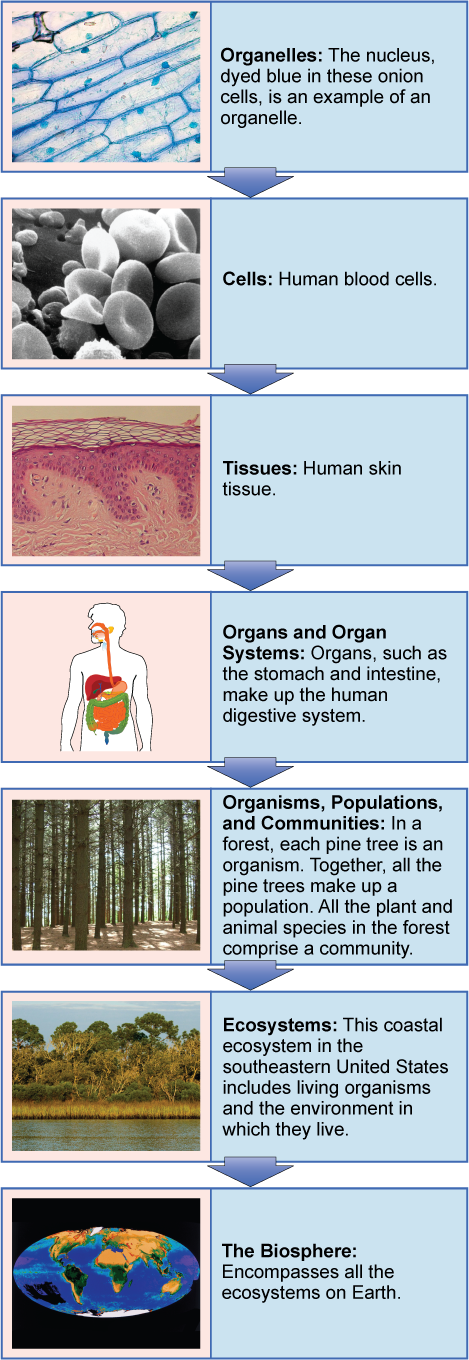
Which of the following statements is false?
- Tissues exist within organs which exist within organ systems.
- Communities exist within populations which exist within ecosystems.
- Organelles exist within cells which exist within tissues.
- Communities exist within ecosystems which exist in the biosphere.
The Diversity of Life
The fact that biology, as a science, has such a broad scope has to do with the tremendous diversity of life on earth. The source of this diversity is evolution, the process of gradual change during which new species arise from older species. Evolutionary biologists study the evolution of living things in everything from the microscopic world to ecosystems.
The evolution of various life forms on Earth can be summarized in a phylogenetic tree (Figure \(\PageIndex{8}\)). A phylogenetic tree is a diagram showing the evolutionary relationships among biological species based on similarities and differences in genetic or physical traits or both. A phylogenetic tree is composed of nodes and branches. The internal nodes represent ancestors and are points in evolution when, based on scientific evidence, an ancestor is thought to have diverged to form two new species. The length of each branch is proportional to the time elapsed since the split.

Evolution Connection: Carl Woese and the Phylogenetic Tree
In the past, biologists grouped living organisms into five kingdoms: animals, plants, fungi, protists, and bacteria. The organizational scheme was based mainly on physical features, as opposed to physiology, biochemistry, or molecular biology, all of which are used by modern systematics. The pioneering work of American microbiologist Carl Woese in the early 1970s has shown, however, that life on Earth has evolved along three lineages, now called domains—Bacteria, Archaea, and Eukarya. The first two are prokaryotic cells with microbes that lack membrane-enclosed nuclei and organelles. The third domain contains the eukaryotes and includes unicellular microorganisms together with the four original kingdoms (excluding bacteria). Woese defined Archaea as a new domain, and this resulted in a new taxonomic tree (Figure \(\PageIndex{8}\)). Many organisms belonging to the Archaea domain live under extreme conditions and are called extremophiles. To construct his tree, Woese used genetic relationships rather than similarities based on morphology (shape).
Woese’s tree was constructed from comparative sequencing of the genes that are universally distributed, present in every organism, and conserved (meaning that these genes have remained essentially unchanged throughout evolution). Woese’s approach was revolutionary because comparisons of physical features are insufficient to differentiate between the prokaryotes that appear fairly similar in spite of their tremendous biochemical diversity and genetic variability (Figure \(\PageIndex{9}\)). The comparison of homologous DNA and RNA sequences provided Woese with a sensitive device that revealed the extensive variability of prokaryotes, and which justified the separation of the prokaryotes into two domains: bacteria and archaea.
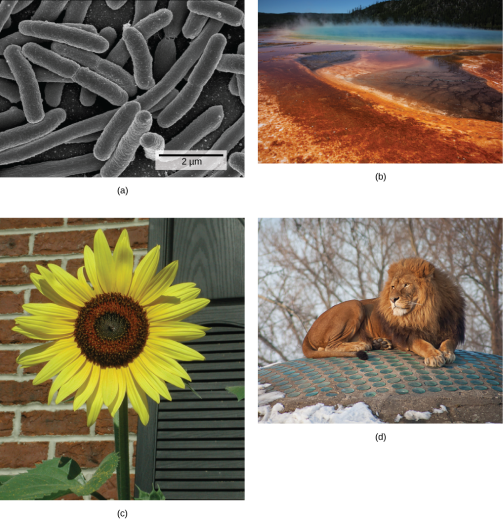
Branches of Biological Study
The scope of biology is broad and therefore contains many branches and subdisciplines. Biologists may pursue one of those subdisciplines and work in a more focused field. For instance, molecular biology and biochemistry study biological processes at the molecular and chemical level, including interactions among molecules such as DNA, RNA, and proteins, as well as the way they are regulated. Microbiology, the study of microorganisms, is the study of the structure and function of single-celled organisms. It is quite a broad branch itself, and depending on the subject of study, there are also microbial physiologists, ecologists, and geneticists, among others.
Career Connection: Forensic Scientist
Forensic science is the application of science to answer questions related to the law. Biologists as well as chemists and biochemists can be forensic scientists. Forensic scientists provide scientific evidence for use in courts, and their job involves examining trace materials associated with crimes. Interest in forensic science has increased in the last few years, possibly because of popular television shows that feature forensic scientists on the job. Also, the development of molecular techniques and the establishment of DNA databases have expanded the types of work that forensic scientists can do. Their job activities are primarily related to crimes against people such as murder, rape, and assault. Their work involves analyzing samples such as hair, blood, and other body fluids and also processing DNA (Figure \(\PageIndex{10}\)) found in many different environments and materials. Forensic scientists also analyze other biological evidence left at crime scenes, such as insect larvae or pollen grains. Students who want to pursue careers in forensic science will most likely be required to take chemistry and biology courses as well as some intensive math courses.
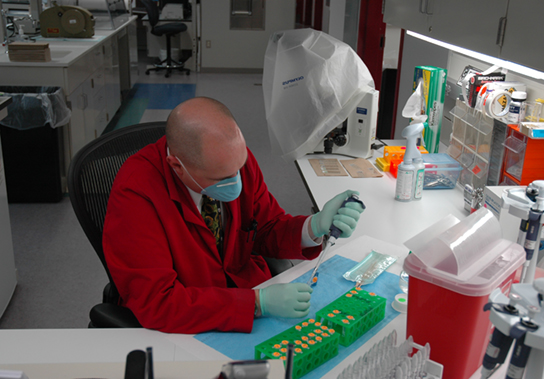
Another field of biological study, neurobiology, studies the biology of the nervous system, and although it is considered a branch of biology, it is also recognized as an interdisciplinary field of study known as neuroscience. Because of its interdisciplinary nature, this subdiscipline studies different functions of the nervous system using molecular, cellular, developmental, medical, and computational approaches.
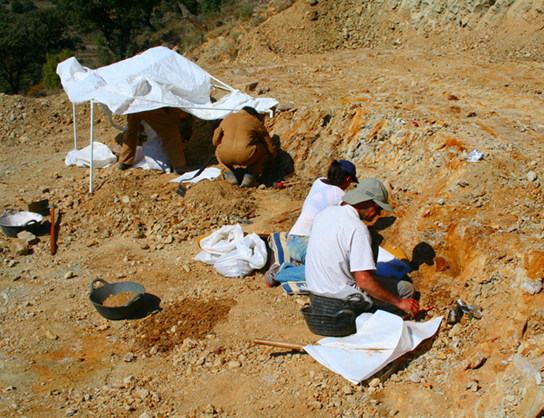
Paleontology, another branch of biology, uses fossils to study life’s history (Figure \(\PageIndex{11}\)). Zoology and botany are the study of animals and plants, respectively. Biologists can also specialize as biotechnologists, ecologists, or physiologists, to name just a few areas. This is just a small sample of the many fields that biologists can pursue.
Biology is the culmination of the achievements of the natural sciences from their inception to today. Excitingly, it is the cradle of emerging sciences, such as the biology of brain activity, genetic engineering of custom organisms, and the biology of evolution that uses the laboratory tools of molecular biology to retrace the earliest stages of life on earth. A scan of news headlines—whether reporting on immunizations, a newly discovered species, sports doping, or a genetically-modified food—demonstrates the way biology is active in and important to our everyday world.
Summary
Biology is the science of life. All living organisms share several key properties such as order, sensitivity or response to stimuli, reproduction, growth and development, regulation, homeostasis, and energy processing. Living things are highly organized parts of a hierarchy that includes atoms, molecules, organelles, cells, tissues, organs, and organ systems. Organisms, in turn, are grouped as populations, communities, ecosystems, and the biosphere. The great diversity of life today evolved from less-diverse ancestral organisms over billions of years. A diagram called a phylogenetic tree can be used to show evolutionary relationships among organisms.
Biology is very broad and includes many branches and subdisciplines. Examples include molecular biology, microbiology, neurobiology, zoology, and botany, among others.
Art Connections
Figure \(\PageIndex{7}\): Which of the following statements is false?
- Tissues exist within organs which exist within organ systems.
- Communities exist within populations which exist within ecosystems.
- Organelles exist within cells which exist within tissues.
- Communities exist within ecosystems which exist in the biosphere.
- Answer
-
Communities exist within populations which exist within ecosystems.
Glossary
- atom
- smallest and most fundamental unit of matter
- biochemistry
- study of the chemistry of biological organisms
- biosphere
- collection of all the ecosystems on Earth
- botany
- study of plants
- cell
- smallest fundamental unit of structure and function in living things
- community
- set of populations inhabiting a particular area
- ecosystem
- all the living things in a particular area together with the abiotic, nonliving parts of that environment
- eukaryote
- organism with cells that have nuclei and membrane-bound organelles
- evolution
- process of gradual change during which new species arise from older species and some species become extinct
- homeostasis
- ability of an organism to maintain constant internal conditions
- macromolecule
- large molecule, typically formed by the joining of smaller molecules
- microbiology
- study of the structure and function of microorganisms
- molecule
- chemical structure consisting of at least two atoms held together by one or more chemical bonds
- molecular biology
- study of biological processes and their regulation at the molecular level, including interactions among molecules such as DNA, RNA, and proteins
- neurobiology
- study of the biology of the nervous system
- organ
- collection of related tissues grouped together performing a common function
- organ system
- level of organization that consists of functionally related interacting organs
- organelle
- small structures that exist within cells and carry out cellular functions
- organism
- individual living entity
- paleontology
- study of life’s history by means of fossils
- phylogenetic tree
- diagram showing the evolutionary relationships among various biological species based on similarities and differences in genetic or physical traits or both; in essence, a hypothesis concerning evolutionary connections
- population
- all of the individuals of a species living within a specific area
- prokaryote
- single-celled organism that lacks organelles and does not have nuclei surrounded by a nuclear membrane
- tissue
- group of similar cells carrying out related functions
- zoology
- study of animals


